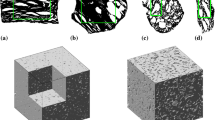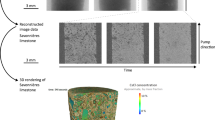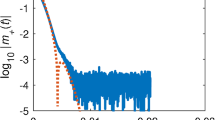Abstract
Conventional laboratory experimentation provides an apparent value of hydraulic permeability which, at best, is representative of the entire sample. Nuclear magnetic resonance imaging (MRI) provides unique opportunities to probe spatial distributions of permeability at a much finer scale (Seto et al., Transp Porous Media 42:351–388, 2001). We advance the methodology for determining spatial distributions of permeability and provide, for the first time, laboratory determinations of permeability distributions with complete three-dimensional (3D) spatial resolution. We investigate new experimental designs that mitigate a possible lack of identifiability and provide for more accurate estimates of permeability. We demonstrate the application of MRI experiments and analyses that provide substantial improvements in the determination of the porosity distribution, an essential step for obtaining reliable measurements of spatially resolved velocity distributions. We investigate the use of global optimization to solve the associated inverse problem for determining permeability distributions from the measured velocity distributions. Our methodology is demonstrated with experimental data on sandstone and trabecular bone samples.
Similar content being viewed by others
Abbreviations
- A c :
-
Cross-sectional area
- \({B_i^m}\) :
-
ith B-spline basis function with the order of m
- c :
-
B-spline coefficient
- c :
-
Column vector of B-spline coefficients
- F :
-
Velocity values calculated from mathematical model
- G :
-
Gram matrix
- g :
-
Gravity
- H :
-
Matrix composed of Gram matrix elements consisting regularization term
- J :
-
Performance index
- K :
-
Permeability tensor
- k(z):
-
Permeability at position z
- k app :
-
Apparent permeability
- k :
-
Wave vector for spin position
- L :
-
Length of sample
- N id :
-
Dimension of the spline in z id direction
- N v :
-
Number of imaging voxels
- n :
-
Normal vector
- P :
-
Normalized displacement distribution function
- p :
-
Pressure
- Q :
-
Volumetric flow rate
- q :
-
Wave vector for spin displacement
- S :
-
NMR signal intensity
- t :
-
Time
- U :
-
Uniform random number
- V :
-
Volume of the sample
- v app :
-
Apparent velocity
- v :
-
Darcy velocity
- W :
-
Weighting matrix
- x :
-
Extended partition of B-spline basis function
- Y :
-
Velocity values measured by experiments
- Z :
-
Position displacement
- z :
-
Position vector
- s :
-
Position vector
- \({\fancyscript{T}}\) :
-
“Temperature” parameter for simulated annealing algorithm
- z id :
-
Position parallel to the dimension id
- Γ:
-
Index representing a set of flow experiments
- Δ :
-
Observation time
- δ :
-
Pulse width of pulsed-gradient-field
- λ :
-
Regularization parameter
- μ :
-
Viscosity
- ρ :
-
Bulk fluid density
- ζ:
-
Joint displacement density (or velocity) function
- \({\phi}\) :
-
Porosity
References
Auzerais F.M., Dunsmuir J., Ferreol B.B., Martys N., Olson J., Ramakrishnan T.S., Rothman D.H., Schwartz L.M.: Transport in sandstone: a study based on three dimensional microtomography. Geophys. Res. Lett. 23, 705–708 (1996)
Brooks S.P., Morgan B.J.T.: Optimization using simulated annealing. Statistician 44, 241–257 (1995)
Callaghan P.T.: Principles of Nuclear Magnetic Resonance Microscopy. Oxford University Press, New York (1991)
Chang C.T.P., Watson A.T.: NMR imaging of flow velocity in porous media. AIChE J. 45, 437–444 (1999)
Chang C.P., Watson A., Edwards C.: NMR imaging of fluids and flow in porous media. Exp. Methods Phys. Sci. 35, 387–423 (1999)
Chen W.H., Galavas G.R., Seinfeld J.H., Wasserman M.L.: A new algorithm for automatic history matching. Soc. Petrol. Eng. J. 14, 593–608 (1974)
Chen S., Qin F., Watson A.T.: Determining fluid saturations during multiphase flow experiments by NMR imaging techniques. AIChE J. 40, 1238–1245 (1994)
Collins R.E.: Flow of Fluids Through Porous Materials. Petroleum Publishing Co., Tulsa (1976)
Geyer C.J., Thompson E.A.: Annealing Markov chain Monte Carlo with applications to ancestral inference. J. Am. Stat. Assoc. 90, 909–920 (1995)
Howes F.A., Whitaker S.: The spatial averaging theorem revisited. Chem. Eng. Sci. 40, 1387–1392 (1985)
Johnston P.R., Gulrajani R.M.: Selecting the corner in the L-curve approach to Tikhonov regularization. IEEE Trans. Biomed. Eng. 47, 1293–1296 (2000)
Kenyon W.E.: Nuclear magnetic resonance as a petrophysical measurement. Nucl. Geophys. 6, 153–171 (1992)
Kenyon W.E., Day P.I., Straley C., Willemsen J.F.: A three-part study of NMR longitudinal relaxation properties of water-saturated sandstones. SPE Form. Eval. 3, 622–636 (1988)
Kilmer M.E., O’Leary D.P.: Choosing regularization parameters in iterative methods for ill-posed problems. SIAM J. Matrix Anal. Appl. 22, 1204–1221 (2001)
Kirkpatrick S., Gelatt C.D., Vecchi M.P.: Optimization by simulated annealing. Science 220, 671–680 (1983)
Kulkarni R.N., Watson A.T.: A robust technique for quantification of NMR imaging data. AIChE J. 43, 2137–2140 (1997)
Kulkarni R., Watson A., Nordtvedt J.E., Sylte A.: Two-phase flow in porous media: property identification and model validation. AIChE J. 44, 2337–2350 (1998)
Liaw H.K., Kulkarni R.N., Chen S., Watson A.T.: Characterization of fluid distributions in porous media by NMR techniques. AIChE J. 42, 538–546 (1996)
Makrodimitris K., Papadopoulos G.K., Philippopoulos C., Theodoroua D.N.: Parallel tempering method for reconstructing isotropic and anisotropic porous media. J. Chem. Phys. 117, 5876–5884 (2002)
Mandava S.S., Watson A.T., Edwards C.M.: NMR imaging of saturation during immiscible displacements. AIChE J. 36, 1680–1686 (1990)
Metropolis N., Rosenbluthand A., Rosenbluth M., Teller A., Teller E.: Equations of state calculations by fast computing machines. J. Chem. Phys. 21, 1087–1092 (1953)
Reginska T.: A regularization parameter in discrete ill-posed problems. SIAM J. Sci. Comput. 17, 740–749 (1996)
Schumaker L.L.: Spline Functions: Basic Theory. Wiley, New York (1981)
Seto, K.: Miscible displacement simulation and permeability characterization in porous media. PhD thesis, Texas A&M University, College Station, TX (1999)
Seto K., Hollenshead J.T., Watson A.T., Chang C.T.P., Slattery J.C.: Determination permeability determinations using NMR velocity imaging. Transp. Porous Media 42, 351–388 (2001)
Slattery J.C.: Momentum, Energy, and Mass Transfer in Continua. Krieger, New York (1981)
Slattery J.C.: Advanced Transport Phenomena. Cambridge University Press, New York (1998)
Tchelepi H.A., Orr F.M. Jr, Rakotomalala N., Salin D., Wouméni R.: Dispersion, permeability heterogeneity, and viscous fingering: acoustic experimental observations and particle-tracking simulations. Phys. Fluids A 5, 1558–1574 (1993)
Tesi M.C., van Rensburg E.J.J., Orlandini E., Whittington S.G.: Monte carlo study of the interacting self-avoiding walk model in three dimensions. J. Stat. Phys. 82, 155–181 (1996)
Uh, J.: Nuclear magnetic resonance imaging and analysis for determination of porous media properties. PhD thesis, Texas A&M University, College Station, TX (2005)
Uh J., Watson A.T.: Nuclear magnetic resonance determination of surface relaxivity in permeable media. Ind. Eng. Chem. Res. 43, 3026–3032 (2004)
Wang X., Ni Q.: Determination of cortical bone porosity and pore size distribution using a low field pulse NMR approach. J. Orthop. Res. 21, 312–319 (2003)
Watson A.T., Gatens J.M. III, Lane H.S.: Model selection for well test and production data analysis. SPE Form. Eval. 3, 215–221 (1988)
Watson A.T., Hollenshead J.T., Uh J., Chang C.T.P.: NMR determination of porous media property distributions. Annu. Rep. NMR Spectrosc. 48, 113–144 (2002)
Whitaker S.: Diffusion and dispersion in porous media. AIChE J. 13, 420–427 (1967)
Whitaker S.: Flow in porous media: a theoretical derivation of Darcy’s law. Transp. Porous Media 16, 3–25 (1986)
Withjack E.M.: Computed tomography for rock-property-determination and fluid-flow visualization. SPE Form. Eval. 3, 696–704 (1988)
Yang P.H., Watson A.T.: Automatic history matching with variable metric methods. SPE Reserv. Eng. 3, 995–1001 (1988)
Yang P.H., Watson A.T.: A Bayesian methodology for estimating relative permeability curves. SPE Reserv. Eng. 6, 259–265 (1991)
Author information
Authors and Affiliations
Corresponding author
Rights and permissions
About this article
Cite this article
Uh, J., Watson, A.T. Determining Spatial Distributions of Permeability. Transp Porous Med 86, 385–414 (2011). https://doi.org/10.1007/s11242-010-9627-3
Received:
Accepted:
Published:
Issue Date:
DOI: https://doi.org/10.1007/s11242-010-9627-3




